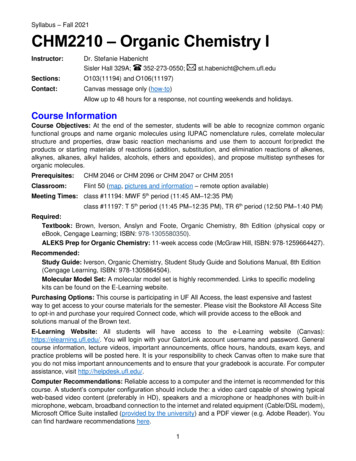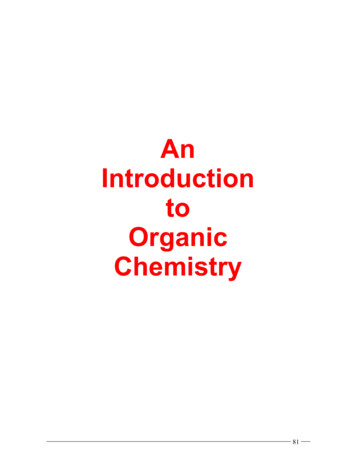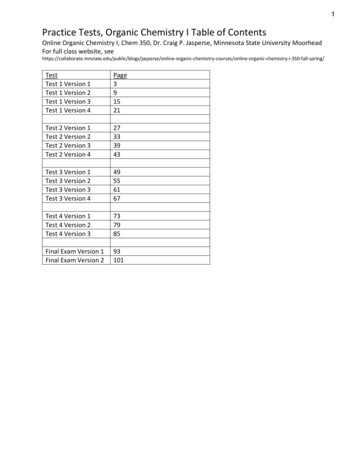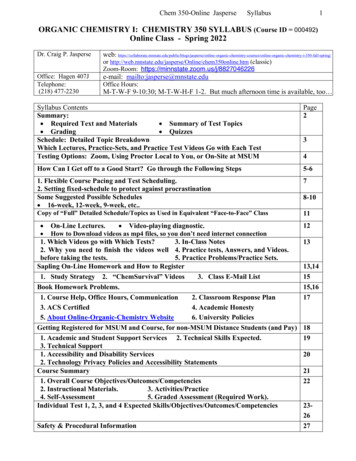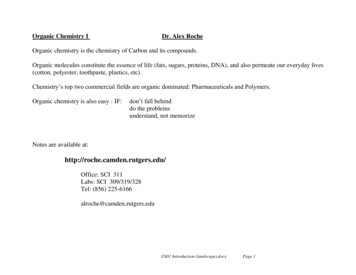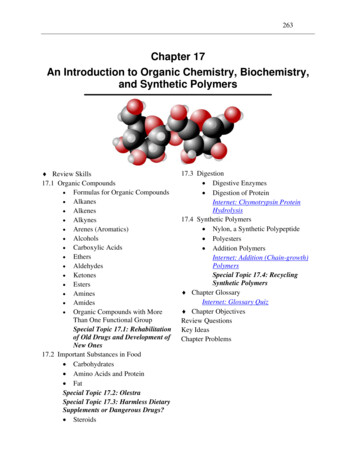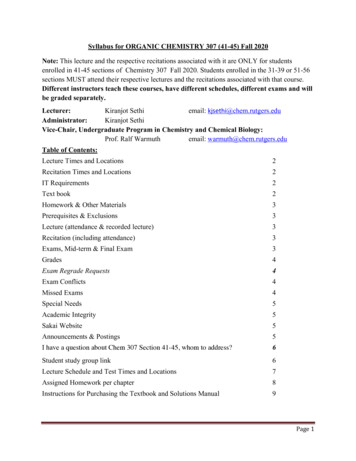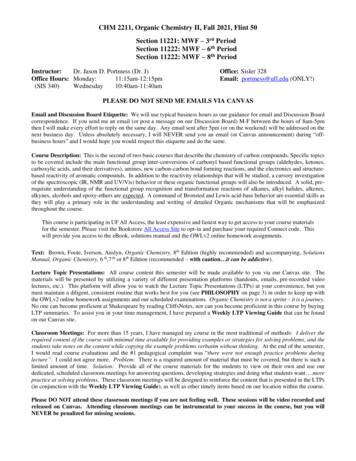
Transcription
TABLE OF CONTENTSChapter 1: Intro to Orgo . XTopics Covered: Introduction to Organic Chemistry Carbon Valence Electrons Octet RuleChapter 2: Drawing in Orgo . XTopics Covered: How to Draw Bonds Condensed Formula Conventional Structural Drawing Line-Angle FormulaChapter 3: Molecular Orbitals, Hybridization and GeometryTopics Covered: Subshells Atomic Orbitals Hybridization Sigma and Pi bonds Geometry Bond Angles COPYRIGHT*2013*STUDYORGO.COM*LCC** . .X
Chapter 4: Lewis Structures, Formal Charge and Resonance Structures .XTopics Covered: What is a Lewis Structure? How do I draw a Lewis Structure? How do I figure out an atom’s formal charge? What is resonance? How do I figure out resonance problems? Major resonance vs. minor resonanceChapter 5: Basic Naming in Orgo- Naming Alkanes .XTopics Covered: Introduction to the concept of nomenclature in Organic Chemistry Step-by-step process for naming alkanesChapter 6: Functional Groups XTopics Covered:Introduction to functional groupsBasic images of each functional group presentedChapter 7: Acid-Base Chemistry XTopics Covered:Arrhenius Acid and Base COPYRIGHT*2013*STUDYORGO.COM*LCC**
Bronstead-Lowry Acid and BaseLewis Acid and BasepKa and pKbAcid-Base ReactionsEffects on acidityEffects on BasicityChapter Eight: Isomers .XTopics Covered:Constitutional isomersConformational IsomersDiastereomersGeometric IsomersConformational Isomers AnalysisNewman ProjectionsCyclohexane Chair ConformationChapter Nine: Chirality and Enantiomers XTopics Covered:Chiral vs. AchiralR and S Nomenclature of EnantiomersProperties of EnantiomersRacemic MixturesMeso CompoundChapter Ten: Introduction to the Study of Orgo Reactions COPYRIGHT*2013*STUDYORGO.COM*LCC** X
Topics Covered:Reaction FormatDegree of Substitution in AlkanesDegree of Substitution in AlkenesReaction Intermediates: Radical, Carbocation, Carbanion COPYRIGHT*2013*STUDYORGO.COM*LCC**
Chapter One: Intro to Orgo1) What is Orgo?a. Organic chemistry, also known as “Orgo” or “O-Chem,” is the study ofmolecular structure and reactions pertaining to living matter. It iscommonly referred to as the study of compounds that contain carbon.b. Why spend an entire year learning about carbon?!?i. Carbon containing compounds are the gateway to life. By studyingorganic chemistry one can have an appreciation for livingorganisms and the basis for life. One can also gain anunderstanding for organic chemistry contributions to health,medicine, pharmacology and industry.2) Carbona. Organic Chemistry is the study of carbon. So let’s review carbon.b. Atomic number 6c. Electron configuration 1s22s22p2d. Valence Electronsi. Definition: The electrons found in the outermost shell in the atom.1. They are the electrons that can participate in bonding.2. Note: Lone pair electrons are a subset of the valenceelectrons that do not participate in bonding.22ii. 1s 2s 2p21. The electrons in the second shell (2s22p2) representcarbon’s valence electrons2. 2 2 4So carbon has four valence electronsiii. In order to complete its octet it needs to share four more electronse. Octet Rulei. Definition: the sum of all bonding electrons and non-bondingelectrons on a given atom in the 2nd row of the periodic table willnever be greater than 8ii. Exceptions to the Octet Rule:1. Hydrogen and Lithium 1 Valence Electron2. Beryllium 2 Valence Electrons3. Elements in period 3 can occupy more than 8 valenceelectrons (e.g. Phosphorus and Sulfur)f. So if carbon has four electrons it may accommodate four more electronsi. How can it do so? It may gain four more bonds1. One bond 2 electrons2. Carbon “takes on” one of those electrons from a given bondtowards its octet COPYRIGHT*2013*STUDYORGO.COM*LCC**
Chapter Two: Drawing in Orgo1) Learning organic chemistry is like learning a new language. With a new languagecomes a new way of speaking and a new way of writing. In organic chemistry wecommunicate with lines and letters.2) How to draw bondsa. Bonds are represented by lines. One line is a single bond, two lines is adouble bond and three lines is a triple bondBondDrawingSingleDoubleTripleb. Bonds may be in a variety of different planesDrawingRepresentationDrawn to represent a bond within same planeas the computer screen or paperDrawn to represent a bond coming out of theplane of the computer screen or paper. Inessence this bond is pointing toward you.Drawn to represent a bond going into the planeof the computer screen or paper. In essence thisbond is pointing away from you.3) General rules of drawing in orgo using the “Line-Angle Formula”a. General Rule #1:i. Anytime there is a line drawn, the atom at each end is a carbonunless otherwise indicated.ii. The appropriate number of hydrogens are attached to it and impliedeven though they may not be drawniii. For example, each of these three are equivalent depictions of thesame compound: COPYRIGHT*2013*STUDYORGO.COM*LCC**
CondensedFormulaConventional StructureDrawingLine-Angle Formula DrawingCH3CH3Looking at this Line-Angle Formula drawing we see a line. Eachend of the line has a carbon. Since the carbons are connected by asingle bond, each carbon has three hydrogens attached to it.b. General Rule #2:i. Each carbon molecule may accommodate four “things” attached toit via a single bond. If there is a double bond that counts as “twothings” if there is a triple bond that counts as “three things”ii. So what about this molecule:Let’s start by circling all the lines:Well, there are three lines, right? Each positioned at an angle toone another to indicate that there is a new carbon at that joint. COPYRIGHT*2013*STUDYORGO.COM*LCC**
So the following two images are equivalent:Conventional Structure DrawingLine-Angle Formula Drawing*Sign-Up for Full Access!For an interactive Exercise Set on Drawing in Orgo, Sign Up and become a memberof StudyOrgo.com. We are so confident in our program that we offer a guarantee like noother. We guarantee you will pass! While many students are happy with just passingthis course, most of the students that we have feedback from, have excelled to be in thetop of their class.For more information and to Sign-Up visit:https://www.studyorgo.com/signup.php******* COPYRIGHT*2013*STUDYORGO.COM*LCC**
Chapter Three: Molecular Orbitals, Hybridization and Geometry1) Atomic orbitalsa. Remember these subshells from general chemistry?i. sii. piii. div. etc.b. Each subshell has a certain number of atomic orbitals (represented bythe lines below)i. sone orbitalii. pthree orbitalsiii. dfive orbitalsc. Each atomic orbital can accommodate two electrons2) Hybridizationa. A hybrid or a mix of atomic orbitalsb. An atom’s orbitals can interact with other atoms and overlap to form agiven hybrid atomic orbitalFor example- here the sp hybrid atomic orbital is formed:3) Molecular Orbitalsa. Molecular orbital overlap of two atomic orbitals from different atomsb. There are two types of bonds formed in molecular orbitals: sigma bondsand pi bonds.c. sigma bond (σ) overlap of hybridized orbitals along the line betweennucleii. single bonds are sigma bondsii. double and triple bonds each have one sigma bondd. pi bond (π) sideways overlap between two p orbitalsi. double bonds have one pi bondii. triple bonds have two pi bondsiii. there must be a sigma bond in order for a pi bond to occure. Summary ChartBondSingleDoubleTripleSigma bonds111Pi bonds012Total1234) Geometrya. An atom has a given hybridization depending on the number of bondsextending from itb. There is also an implicit geometric shape associated with the hybridizationc. Furthermore, the bond angles formed are importantd. Here is a chart that sums this up: COPYRIGHT*2013*STUDYORGO.COM*LCC**
BondHybridizationGeometryBond angleSinglesp3Tetrahedral109.5 Doublesp2Trigonal planar120 TriplespLinear180 Picture5) Ways carbon can bond to othersa. Option #1: Carbon may accommodate four single bondsb. Option #2: Carbon may accommodate one double bond and two singlebondsc. Option #3: Carbon may accommodate two double bondsd. Option #4: Carbon may accommodate one triple bond and one singlebond COPYRIGHT*2013*STUDYORGO.COM*LCC**
Sign-Up for Full Access!For an interactive Exercise Set on Molecular Orbitals, Hybridization and Geometry,Sign Up and become a member of StudyOrgo.com. We are so confident in ourprogram that we offer a guarantee like no other. We guarantee you will pass! Whilemany students are happy with just passing this course, most of the students that wehave feedback from, have excelled to be in the top of their class.For more information and to Sign-Up visit:https://www.studyorgo.com/signup.php COPYRIGHT*2013*STUDYORGO.COM*LCC**
Chapter Four: Lewis Structures, Formal Charge and Resonance Structures1) What is a Lewis Structure?a. A way to draw out electrons and bonding by using dots2) How do I draw a Lewis Structure? Let’s go step by step and demonstrate usingCO2 as an example.a. Step 1: Determine the number of valence electrons an atom has toparticipate in bonding.i. Remember: Valence electrons are the electrons in the outermostshell of an atom. Some valence electrons participate in bonding toanother atom. Others, known as lone pairs, do not.ii. The number of valence electrons that participate in bonding forpopular atoms are as follows: C 4 N 3 O 2 F 1 H 1ii. For example: In CO2 we have C (draw 4 dots) and O (draw 2 dotsper atom)b. Step 2: Place a dot around that atom for each valence electron thatparticipates in bondingi. For example:c. Step 3: Determine the lone pairs for a given atom:i. Remember: Lone pairs are a subset of the valence electrons thatdo not participate in bonding to another atomii. Lone pairs for popular atoms are as follows:1. C 02. N 1 pair 2 electrons3. O 2 pairs 4 electrons4. F 3 pairs 6 electrons5. H 0iii. For example, in CO2 we have C (no lone pairs) and O (two lonepairs per atom)d. Step 4: Place the lone pairs around the atom using a pair of dots to depicteach lone pair.i. For example:e. Step 5: Wherever there is an atom bonding to another atom there are twodots between them, one from each atom. You may decide to convert thispair of electrons into a line to denote a bond.i. For example:3) How do I figure out an atom’s formal charge?a. Step 1: Count the atom’s lone pair electrons COPYRIGHT*2013*STUDYORGO.COM*LCC**
b. Step 2: Count one from each pair of electrons that particular atom is usingto bond to another atomc. Step 3: Add the number you get from Step 1 to Step 2d. Step 4: The formal charge is whatever you need to do to the number yougot from step 3 to get to the atom’s group number on the periodic tablee. For example: Let’s use an O atom in CO2 as an exampleAdd the lone pair electrons (4) to one from each pair of bonding electrons(2) 6Since oxygen is in group 6 in the periodic table the formal charge is 0(zero). (You do not need to do anything to the number you get from step 3to get to the atom’s group number on the periodic table)4) What is resonance?a. A drawn structure with a double bond on its own does not completelyrepresent the structure of a given moleculei. There can be more than one possible structure for the samemolecule!ii. The actual structure is the average of all of the resonancestructures5) Why resonance?a. Resonance spreads the charge over two atoms which makes the structuremore stable6) How do I figure out resonance problems? Follow these simple rules:a. Rule #1: Try moving around electrons.i. When moving electrons use an arrow to demonstrate where theelectrons are going.ii. Electrons can be moved around in one of two ways:1. Move double bond electrons2. Move lone pair electronsb. Rule #2: The number of unpaired electrons must remain the samec. Rule #3: Figure out which of your drawings represent the major and minorstructuresi. Major resonance the resonance contributors that are morestable as they have the least energy. Low energy structures satisfyas many of the following as possible:1. There are as many octets as possible2. There are as many bonds as possible3. There are as few lone pairs as possible4. Any negative charges are placed on the mostelectronegative atomsa. Most electronegative F O Cl N C leastelectronegative5. There is the least separation of charge amongst thestructures COPYRIGHT*2013*STUDYORGO.COM*LCC**
ii. Minor resonance the resonance contributors that are less stableas they have the most energy. High energy structures do notsatisfy as many of the above guidelinesd. Example: NO3i. In the following example NO3- is drawn out showing three differentresonance structures. Please remember that while electrons aremoving around no atoms are moving.ii. The arrows show the movement of the electrons to show how toarrive at the next structure moving from the left to the right of thescreen.iii. Since all three structures satisfy the same guidelines to the sameextent as outlined above, all three are equal contributors. Howeverthis is often not the case and will be seen in the next exercise set.Sign-Up for Full Access!For an interactive Exercise Set on Lewis Structures, Formal Charge and ResonanceStructures, Sign Up and become a member of StudyOrgo.com. We are so confidentin our program that we offer a guarantee like no other. We guarantee you will pass!While many students are happy with just passing this course, most of the students thatwe have feedback from, have excelled to be in the top of their class.For more information and to Sign-Up visit:https://www.studyorgo.com/signup.php COPYRIGHT*2013*STUDYORGO.COM*LCC**
Chapter Five: Basic Naming in Orgo- Naming Alkanes Each structure in organic chemistry has its own nameAlkanes are one of the first structures to learn about when starting to studyOrganic Chemistryo Alkanes are molecules that are composed entirely by single bonds. Follow these three simple steps to arrive at a name for a given molecule.o We will use this molecule as an example to demonstrate each step:Step #1: Find the longest chain of carbons in the molecule and number themstarting with the carbon closest to a branch. Note: If there is a branch at the same point at either end, start numbering at theend closest to the largest branch. If the branches are of equal size at the samepoint at either end, start numbering at the end where the next branch is closer.*Step #2: The number of carbons tells us the main stem of the structure’s name So in total that’s four carbons as part of the longest chain. This chart lists prefixes for structures based off the number of carbons in thelongest chain. When naming alkanes, the three letter suffix “-ane” can be joinedwith the appropriate prefix to arrive at the main stem of the name.COPYRIGHT*2013*STUDYORGO.COM*LCC**
Number ofcarbons in thelongest chain1234567891011121314PrefixMain stem of name ifstructure is an caneTetradecane OK- so back to our example: In this case the prefix is ButSince it is made up of all single bonds, the structure is an alkane, and thereforethe suffix is –anePut together the prefix and the suffix and you have the main stem of the name.Prefix suffix main stem of the nameo In this case But- -ane Butane Note: Other structure types will have different suffixes. For example, a structurewith a double bond, is not an alkane, rather it is an alkene. Therefore the suffixwould be “-ene.” A structure with a triple bond would have the suffix eStep #3: Is there anything else on that chain? If so—add it to the main stem of thename. COPYRIGHT*2013*STUDYORGO.COM*LCC**
Here there is a CH3 group. This is known as a methyl group. It is a type of alkylgroup, which means a branch off a main molecule made up of carbons andhydrogen.o So you will need add that to the name. Check and see what carbon it is attached to—OK so it is attachedto carbon #2. You need to add the numbered carbon, then a hyphen, then thesubstituent’s name. So the full name of this structure is:2-methylbutaneSome Important Details:1) If there is more than one structure attached to the same carbon, list them inalphabetical order2) If there is more than one of the exact same structure in the compound, then use thefollowing table of prefixes to annotate the substituent name in the final overall nameNumber of theexact samegroup2345Prefixditritetrapenta-3) To make naming easier, commit the following common alkyl groups and their namesto memory:Alkyl groupName(The letter Z stands for “the rest of thecompound”)Methyl COPYRIGHT*2013*STUDYORGO.COM*LCC**
yl COPYRIGHT*2013*STUDYORGO.COM*LCC**
Sign-Up for Full Access!For an interactive Exercise Set on Basic Naming in Orgo- Naming Alkanes, Sign Upand become a member of StudyOrgo.com. We are so confident in our program that weoffer a guarantee like no other. We guarantee you will pass! While many students arehappy with just passing this course, most of the students that we have feedback from,have excelled to be in the top of their class.For more information and to Sign-Up visit:https://www.studyorgo.com/signup.php COPYRIGHT*2013*STUDYORGO.COM*LCC**
Chapter Six: Functional Groups There are many identifying structures within compounds known as functionalgroups. Here is a table of the main functional groups in organic chemistry.Functional R-XR-OHR-O-RAromaticAmineAldehydeKetone COPYRIGHT*2013*STUDYORGO.COM*LCC**R-NH2R2-NHR3-N
NitrileAmideAcyl HalideEsterAcid AnhydrideCarboxylic AcidKey R represents an unspecified hydrocarbon chainattached to a given molecule (example: CH2CH3)X represents an unspecific halogen attached to agiven molecule (examples: F, Cl, Br, I)COPYRIGHT*2013*STUDYORGO.COM*LCC**
Sign-Up for Full Access!For an interactive Exercise Set on Functional Groups, Sign Up and become amember of StudyOrgo.com. We are so confident in our program that we offer aguarantee like no other. We guarantee you will pass! While many students are happywith just passing this course, most of the students that we have feedback from, haveexcelled to be in the top of their class.For more information and to Sign-Up visit:https://www.studyorgo.com/signup.php COPYRIGHT*2013*STUDYORGO.COM*LCC**
Chapter Seven: Acid-Base Chemistry1) Acid-Base DefinitionsAcidBaseArrheniusDissociation in water yields H Dissociation in water yields -OHBronstead-LowryProton (H ) donorProton (H ) acceptorLewisElectrophile (a compound thataccepts electrons)Nucleophile (a compound that donateselectrons)2) pKa and pKba. Equations:i. (Ka) x (Kb) 1 x 10-14ii. (pKa) (pKb) 14iii. pKa -log10[Ka]b. The lower the pKa, the stronger the acidc. The higher the Ka, the stronger the acidd. Weaker acids (low Ka or high pKa) and weaker bases (low Kb or highpKb) are favored in acid-base reactions.3) Acid-Base Reactionsa. Depicted here is a sample acid-base reaction The arrows are used to demonstrate the movement of electrons.The Lewis Base is donating electrons to the Lewis Acid. The redarrow shows this. Once this occurs, the Br leaves the acid. Theelectrons that were originally shared with the rest of the acid leaveto exist on the Br alone.4) Effects on aciditya. The more readily a compound can donate a proton, the more acidic itis.b. Certain functional groups are more acidic that others. Here are somerepresentative functional groups and compounds listed in order from mostacidic to least acidic. See Chapter Six for review of functional groups.i. Carboxylic acidii. Phenol (aromatic compound with OH attached to it) COPYRIGHT*2013*STUDYORGO.COM*LCC**
iii. Wateriv. Alcoholv. Ketonevi. Alkynevii. Alkeneviii. Alkanec. The more stable a molecule is without a proton, the more easily it will giveit up and become deprotanated.1. The more electronegative the atom connected to the carbonwith an OH, the more electropositive the H is, the moreacidic it is, and the more likely it will donate it.d. Strong acids have weak, stable, conjugate bases.i. The more the conjugate base is stabilized by resonancedelocalization, the more stable the base is.e. The higher the electronegativity of the atom in a compound, the higher theacidityi. eg: HF is more acidic than HCH3f. The greater the acidity the more readily it will react with a base.5) Effects on Basicitya. The more readily a compound donates electrons the more basic it is.i. The more lone pairs a base has, the more basic it is.b. The weaker the conjugate acid the stronger the conjugate base.c. The more stable the base the less basicd. Effect of charge on basicityi. No negative charge more stable least basicii. Negative charge on carbon is least stable more basiciii. Negative charge on electronegative atom more stable lessbasicSign-Up for Full Access!For an interactive Exercise Set on Acid-Base Chemistry, Sign Up and become amember of StudyOrgo.com. We are so confident in our program that we offer aguarantee like no other. We guarantee you will pass! While many students are happywith just passing this course, most of the students that we have feedback from, haveexcelled to be in the top of their class.For more information and to Sign-Up visit:https://www.studyorgo.com/signup.php* COPYRIGHT*2013*STUDYORGO.COM*LCC**
Chapter Eight: Isomers1) Isomers OverviewIsomers compounds that are not the same but share the same molecularformulaExampleIsomer TypeStructural Isomers constitutionalisomersCompounds that have a difference in theorder in which the components are bondedConformational IsomersCompounds that differ in the rotation abouta single bondStereoisomersCompounds that differ in the way they are orientedADiastereomersStereoisomers that are NOTmirror imagesA-1 Geometric IsomersDiastereomers thatdiffer specificallyregarding theorientation of thesubstituents of a doublebond or ring in a cis ortrans orientation COPYRIGHT*2013*STUDYORGO.COM*LCC**
BEnantiomersStereoisomers that are mirrorimages2) Conformational Isomers Analysisa. Newman projections a way to depict the different arrangements formedby rotation about the single bond of a molecule1. For example, in this conventional drawing of butane, one canappreciate that the structure can be rotated about its single bond2. Understanding Newman projections:The following images of the traditional structure drawing andcorresponding Newman projection are color coordinated todemonstrate their relationship: COPYRIGHT*2013*STUDYORGO.COM*LCC**
b. What are the different types of conformational isomers? Here we definethem by using butane as an example. We will go through the conformersby starting in the totally eclipsed position and rotate about the single bondfrom there.1. Totally Eclipsed – methyl groups are aligned with one anotheri. There is torsional strain between groupso Repulsion of electron cloudsii. There is steric hindranceo The interference between two bulky groupsiii. These are the least stable of the conformationsiv.They possess the highest potential energy of theconformations2. Gauche – When the methyl groups are staggered to the left or rightof one another at a 600 anglei. More stableii. Lower potential energy3. Eclipsed – Eclipsed position, but methyl groups are not eclipsedand are at a 1200 angle to one anotheri. Less stableii. Higher potential energy4. Anti – When the methyl groups are staggered to be completeopposite on another and are at a 1800 anglei. Most stableii. Least potential energyc. Chair conformations1. Cyclohexane can be drawn in its conventional form, or in a varietyof 3-D like model drawings. An important such conformation isknown as a chair conformation. COPYRIGHT*2013*STUDYORGO.COM*LCC**
2. The chair conformation can flip between two different positions:3. Positions on the chair conformation4. The chair conformations also demonstrate the importance ofminimizing repulsion between groups to increase stability of amolecule5. 1,3 di-axial versus 1,3 di-equatoriali. 1,3 di-axial very unfavorable due to steric hindrancebetween bulky groupsii. 1,3 di-equatorial much more favorable as sterichindrance is minimized and the structure is much morestable COPYRIGHT*2013*STUDYORGO.COM*LCC**
Sign-Up for Full Access!For an interactive Exercise Set on Isomers, Sign Up and become a member ofStudyOrgo.com. We are so confident in our program that we offer a guarantee like noother. We guarantee you will pass! While many students are happy with just passingthis course, most of the students that we have feedback from, have excelled to be in thetop of their class.For more information and to Sign-Up visit:https://www.studyorgo.com/signup.php COPYRIGHT*2013*STUDYORGO.COM*LCC**
Chapter Nine: Chirality and Enantiomers1) Chirala. Definition: a plane of symmetry does NOT exist in a given structureb. Two objects are chiral if they are NOT superimposable on one another2) Achirala. Definition: a plane of symmetry DOES exitst in a given structureb. Two objects are achiral if they are superimposable on one another3) Enantiomersa. Definition: Two isomers that are mirror images of one anotherb. Enantiomers are chiral and they are NOT superimposable on one anotherc. Chiral carbonsi. A chiral carbon has four different items attached to it.ii. A chiral carbon is also known as asymmetric carboniii. The chiral carbon is the chirality center of the moleculeiv. Enantiomers possess chiral carbons.4) R and S nomenclaturea. Used to assign an identifying label to each chiral carbon in a givenenantiomeri.b. How to determine R and S nomenclaturei. Step 1: Find the chiral carbonii. Step 2: Assign the numbers 1 through 4 to each item attached tothat carbon.1. Assign 1 to the item that is of highest priority through 4 to theitem of lowest priority2. Hierarchy of priority (in order from most important to leastimportant)a. Halogens (I Br Cl F)b. Oc. Nd. Ce. H3. Some important notes:a. Often you will have a tie. In that case, go to the nextitem after that atom to break the tie and determine thepriority.b. When encountering double or triple bonds, pretendthey are single bonds and duplicate the itemsattached to that bond. Duplicate twice for triple bonds.iii. Step 3: Draw a circle from 1 to 2 to 3 to 4. COPYRIGHT*2013*STUDYORGO.COM*LCC**
1. Before starting look and see where item #4 is. If item #4 iswithin the plane of the screen or paper redraw the imageto have item #4 going into the plane of the screen or paperbefore continuing.a. If item #4 is going into the screen or paper or comingout of the screen or paper, continue as follows.2. Determine if the circle was drawn clockwise orcounterclockwise.3. If the circle was drawn clockwise assign the letter “R”4. If the circle was drawn counterclockwise assign the letter“S”5.iv. Step 4: Check and see where the item #4 is1. Usually this item is a hydrogen. If item #4 is in the planepositioned behind you or is going into the plane of thescreen or paper then leave the assigned letter as is.However, if item #4 is position in front of you or is coming outof the place of the screen or paper, then assign theopposite letter from what you assigned in Step 3.2. If item #4 is going into the place of the screen or paper leave alone3. If item #4 is coming out of the plane of the screen or paper assign the opposite lettera. If R was chosen new assignment is Sb. If S was chosen new assignment is R4. Remember, if item #4 is within the plane of the screen orpaper redraw the image to have item #4 going into theplane of the screen or paper before determining clockwise orcounterclockwise (see step 3 above.v. Example:Step 1: Find the chiral carbon COPYRIGHT*2013*STUDYORGO.COM*LCC**Step 2: Assign the numbersHere they are according to the hierarchy ofpriority outlined above#1: Cl#2:CH2CH3 There are two carbons directlyattached to the chiral carbon. In orderto break the tie, we look to see what isattached to those carbons. TheCH2CH3 substituent has a furthercarbon attached, while the CH3substituent only has hydrogen attachedtherefore CH2CH3 wins.#3: CH3#4: H
Step 3: Draw a circle from 1 to 2 to 3 to 4In this case the circle drawn is clockwise.Therefore the assignment is RStep 4: Check and see where the item#4 isSince item 4 is already in the back theassignment stays the way it is at R5) Properties of Enantiomersa. A pair of enantiomers almost have identical properties. They differ inone aspect:i. Two enantiomers rotate plane-polarized light in oppositedirections1. Plane polarized light are light waves that travel only in oneplane2. This is referred to as optical activity3. Clockwise rotations are abbreviated by a ( ) or the letter“d”4. Counterclockwise rotations are abbreviated by a (-) or theletter “l”6) Racemic mixturea. Definition: When equal amounts of each enantiomer of a pair of mixedtogether COPYRIGHT*2013*STUDYORGO.COM*LCC**
b. While each individual enantiomer on its own it optically active, when thetwo equal amounts are mixed together, the mixture is NOT opticallyactive7) Meso compounda. Definition: A structure that possesses both a plane of symmetry and atleast one asymmetric carbon. Meso compounds are achiral.b. Example:Plane of symmetrySign-Up for Full Access!For an interactive Exercise Set on Chirality and Enantiomers, Sign Up and becomea member of StudyOrgo.com. We are so confident in our program that we offer aguarantee like no other. We guarantee you will pass! While many students are happywith just passing this course, most of the students that we have feedback from, haveexcelled to be in the top of their class.For more information and to Sign-Up * COPYRIGHT*2013*STUDYORGO.COM*LCC**
Chapter Ten: Introduction to
organic chemistry one can have an appreciation for living organisms and the basis for life. One can also gain an understanding for organic chemistry contributions to health, medicine, pharmacology and industry. 2) Carbon a. Organic Chemistry is the study of carbon. So let’s review c
